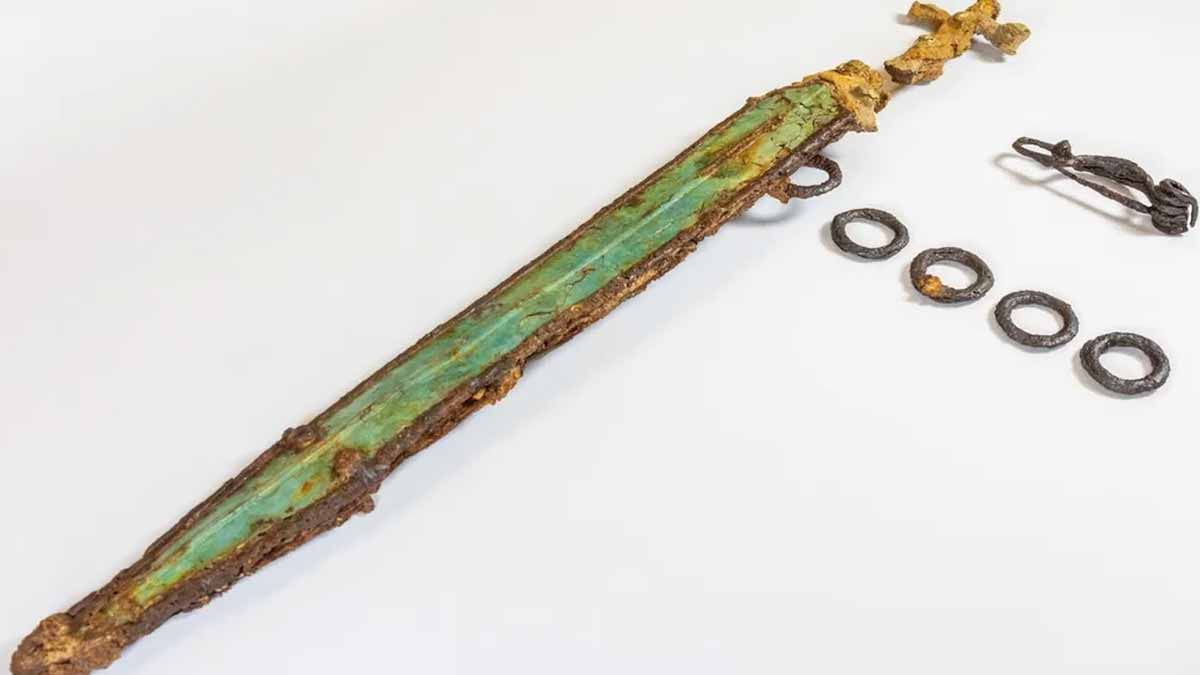A rare glint rises from a French hillside, where two Iron Age blades still shine through time. Their metal carries stories, their fittings whisper of rank, trade, and ritual, and their ancient symbols point beyond war toward belief. Nothing here feels static because each detail, paired with another, redraws what we know about Celtic life while keeping just enough mystery to pull us closer.
Hilltop cemetery where ancient symbols and craft converge
Set above Creuzier-le-Neuf in central France, a burial ground from the early fourth century B.C. spans nearly 7,000 square feet, an unusual scale for La Tène-period France. Benjamin Oury of INRAP leads the excavation and says each object helps map a political crossroads because tribes met here and exchanged more than goods. Soil acidity erased bones, yet iron-oxide cocoons held metal offerings in place.
Almost half of more than one hundred grave pits still sheltered jewelry, weapons, or costume fittings that slid free once conservators separated rust from soil. The enclosure is quadrangular, its ditch wide enough to signal communal labor rather than a narrow family plot. Rows run north to south, so the plan looks ordered and points to coordinated rites rather than hurried burials.
Only one tomb held a cremation. It included a painted clay vase with red spirals that echo Mediterranean fashions, as other Second Iron Age cemeteries show. Such decorated urns rode trade routes toward the Rhône Valley and beyond, and this hilltop fits that wider pattern because exchange shaped ritual choices, then left durable clues.
Two swords, two functions in one resting place
One sword is long and functional. It hangs at a horseman’s waist in life, its scabbard edged with cabochons of glass paste. Textile fragments clung to the back plate, probably from the dead person’s cloak, and X-rays show the belt rings had never been pried away. Oxidation respected geometry, so conservators measured the blade within two millimeters of its working length.
The second sword is shorter and ceremonial. Its leaf-shaped blade ends in a copper hilt tipped with small bronze balls called antennae. Vincent Georges of INRAP notes it is roughly contemporary with Celtic incursions in northern Italy and the sack of Rome in 387 B.C., so its presence in the cemetery links status display to a turbulent era, while the steel that rode to battle likely belonged to others.
Both blades compress social meaning. The long weapon signals readiness and rank; the short one projects identity because ancient symbols turn metal into message. Cabochons suggest imported glass, as bracelets and brooches around the graves suggest coordinated dress. Function yields to ceremony in places, yet ceremony leans on craft because craft carried value that traveled.
Jewelry, brooches, bracelets and shared workshops
Eighteen fibulas surfaced in fragile bundles, iron and copper-alloy together, then stabilized cleanly in Vienna’s CREAM laboratory. One brooch carries a silver-leafed gem. Another shows ocelli, eye-shaped bosses favored by Celtic artisans in the fifth and fourth centuries B.C., so the cemetery’s ornaments match the period’s style while also showing fine local taste.
Bracelets came in pairs for several burials. Their terminals socket so neatly the clasp vanishes when closed because metal meets metal with millimeter care. A matched set bears concentric rings punched so deeply that fresh hammer marks still catch light under magnification, which means technique mattered as much as shine and speaks to trained hands practicing repeatable patterns.
Copper spheres sit atop some clasps like berries on a stem, a motif echoed on harness fittings in Champagne burials two hundred miles away. Such shared grammar implies workshops traded not only goods but also models across tribal frontiers. So ancient symbols did not stand alone; they sat inside networks of makers, buyers, and rules of taste.
Tracing ancient symbols across trade, skies and time
Two gems on the ceremonial scabbard carry crisp engravings of the swastika, a right-angled cross read in many ancient cultures as luck or cosmic motion. Historian Lorraine Boissoneault documents the sign on artifacts from India to the Mississippi Valley long before its modern appropriation, so context decides meaning here as craft meets belief.
Classical collections show the motif spreading across the Mediterranean by the sixth century B.C., then drifting north with Celtic migration. Its presence beside a crescent and a full circle inlaid on the blade suggests celestial or solar intent rather than boastful battle marks, as combined signs lean toward cycles and light instead of violence and fear.
This may be Western Europe’s earliest example carved into gemstone on a sword, a technique closer to Hellenistic seal rings. Hybrid artistry proves borders were porous even during local feuds because ideas move with people, traders, and gifts. Designs pass from hand to hand, then settle on prestige objects that fix them in time.
On a frontier where tribes met and memory endured
Creuzier-le-Neuf sits where Arverni, Aedui, and Bituriges territories overlapped, so a liminal patch prospered on exchange and tension. Trade beads from Mediterranean workshops entered local rivers as Arverni bronze flowed south through alpine passes, while all three tribes kept fortified oppida within a day’s march and still buried their dead together here.
Shared ground hints at overlapping kin or a common sacred place. History remembers the wider Celtic world routing Rome at the Battle of Allia on July 18, 387 B.C., a clash that ended with gold paid for freedom. The ornamental sword dating to that generation suggests prestige objects doubled as badges while real steel rode to war.
Isotope work planned for scabbard alloys may track ore to the Massif Central or farther sources tied to alliances. No slash notches scar the blade edges, confirming the shorter sword lived as insignia. Objects narrate diet, trade, and hierarchy because cabochons likely held imported glass and bracelets mirror La Tène type-A catalogs, so ancient symbols and materials fused rank with story.
